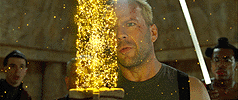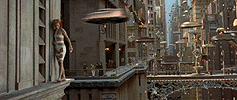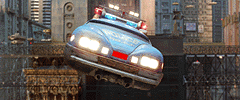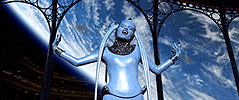Spotlight : July 1997
Super35 and THE FIFTH ELEMENT
By Todd Vaziri
Spotlight : July 1997
Super35 and THE FIFTH ELEMENT
By Todd Vaziri
Southern California's Digital Domain has worked on some amazing visual
effects-filled movies in the past few years, three of which were films
shot in the Super35 format. Super35 is a process that allows a film to
enjoy a widescreen release for theatrical prints, while giving the
filmmaker choices in the video transfer for home video and television
versions. Although the format certainly has its drawbacks, it is a highly
attractive route for visual effects films.
The choice between shooting a widescreen film in the anamorphic format and the Super35 format is extremely important when it comes to visual effects. The differences between the formats are quite startling both in procedure and expense.
"In terms of Digital Domain's ability to work with production footage as
elements, there are certain added costs involved with using anamorphic," Stetson said. Each frame of production footage used in a visual effect must be scanned into Digital Domain's computers. For anamorphic features, the footage must go through an extra step of "un-squeezing"; the squeezed anamorphic image must be decompressed to
allow artists to create their visual effects elements. "Substantially more computer storage space is involved with this process."
Super35 gave Digital Domain more freedom in using production cameras to
shoot elements, such as greenscreen photography and background plates.
"With Super35, you can work with normal spherical lenses and production
cameras, which is a big advantage when it comes to visual effects work."
In THE FIFTH ELEMENT's case, Digital Domain was actually able to use Arri
cameras to shoot greenscreen elements and background plates. "We were
able to use a new Arri 435 prototype that was simply marvelous--it was
rock solid at any frame rate we set, between 1fps to 150fps."
Director Besson, however, did not take full advantage of the Super35
format, in that he did not elect to use the full negative. "It was
decided early on that we would essentially 'hard matte' the film at a 2.35 to 1 aspect ratio; we were only going to use the center widescreen image for the final film and subsequent video releases. Although we at Digital Domain hoped for him to hard matte at 1.66:1, Besson was very firm in wanting the 2.35 to 1 ratio, to protect his creative control over his original composition."
"The production certainly got more bang for their buck, by using Super35
on this film instead of anamorphic. It was essentially a trade-off
between the subtle quality gains of full-negative anamorphic, and the
extra time we could spend pushing the limits of art direction and visual
effects. For this project, Luc made the right choice to get the most
value on the screen."
 1997's imaginative and visually stunning THE FIFTH ELEMENT, directed by
Luc Besson, is one of the year's biggest visual effects films. At the
suggestion of Digital Domain, the effects house responsible for the film's
visual effects, THE FIFTH ELEMENT was shot in Super35. Supervising the
film's 225 effects was Mark Stetson, and he spoke with me about the
production's use of the Super35 format.
1997's imaginative and visually stunning THE FIFTH ELEMENT, directed by
Luc Besson, is one of the year's biggest visual effects films. At the
suggestion of Digital Domain, the effects house responsible for the film's
visual effects, THE FIFTH ELEMENT was shot in Super35. Supervising the
film's 225 effects was Mark Stetson, and he spoke with me about the
production's use of the Super35 format.
 Luc Besson, director of THE FIFTH ELEMENT, created all of his previous features in widescreen using the anamorphic process. A director with a clear, distinctive vision, Besson likes to have complete control over his compositions. When Digital Domain and Stetson introduced the idea of Super35 to Besson, he was skeptical, yet open to the idea.
Luc Besson, director of THE FIFTH ELEMENT, created all of his previous features in widescreen using the anamorphic process. A director with a clear, distinctive vision, Besson likes to have complete control over his compositions. When Digital Domain and Stetson introduced the idea of Super35 to Besson, he was skeptical, yet open to the idea.
 Stetson adds that anamorphic lenses are prone to "chromatic aberration...
each of the primary colors comprising emulsion layers of film focus
slightly differently. For normal production photography, it's hardly
noticeable, but for digital post-production, it can create some matte
problems."
Stetson adds that anamorphic lenses are prone to "chromatic aberration...
each of the primary colors comprising emulsion layers of film focus
slightly differently. For normal production photography, it's hardly
noticeable, but for digital post-production, it can create some matte
problems."
 This decision, although eliminating other visual effects concerns, means
that when THE FIFTH ELEMENT is viewed in full-screen video (pan & scan),
40% of Digital Domain's work will be cut off from the left and right sides
of the screen.
This decision, although eliminating other visual effects concerns, means
that when THE FIFTH ELEMENT is viewed in full-screen video (pan & scan),
40% of Digital Domain's work will be cut off from the left and right sides
of the screen.
Links: THE FIFTH ELEMENT, Digital Domain.
Back to the Spotlight Main Menu

. . VFX HQ Produced by Todd Vaziri . . http://www.vfxhq.com . . e-mail: tvaziri@gmail.com . .
All text Copyright © 1998 Todd Vaziri, unless otherwise noted